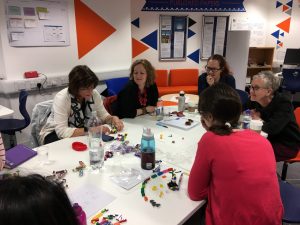Curie Scott and Susanne Clarke recently ran a facilitation workshop for CEL and Service Excellence. We needed a group who were open to new ideas, brimming with curiosity and a love of trying something new. In short people who make learning fun and effective. That is what we got, a group of wonderful people who embraced using Lego© to support discussion around a strength based theme
When we bring creative approaches such as Lego© bricks into learning, we are building on many techniques that support the creative process through the medium of an artefact or image. Lego takes this a few steps further as it embraces the link between hand and brain.
Let me explain – if we have a learning outcome, challenge or question to focus on, if asked to write a list we will tend to just come up with what we already know. If we bring in creative approaches these help to spark new ideas, we go beyond what we already know.
We might also need to encourage open dialogue, so might then ask questions and wait for the group to respond, but what about those who don’t speak, or might feel uncomfortable proposing something a bit different? This is where Lego© (Serious Play), has been demonstrated to be an effective approach to introducing something “in the middle”, using mediated dialogue (Palus, McGuire, 2015).
https://www.ccl.org/wp-content/uploads/2015/07/mediated-dialogue-see-your-way-through-change.pdf
Lego© in facilitation can be adapted in many ways, and we used a 4 step model:-
1. The Challenge – Question
2. Build a model – Metaphor
3. Sharing – Give meaning – Tell your story
4. Questions and Reflections
As our workshop was based on strength based approaches, an Appreciative Inquiry, the question we asked was “In a good day at work, what is happening”? This led to really interesting conversations, with some common themes, including the joy that seeing others achieve brings us and a sense of achievement in helping others. An interesting theme around ‘Order versus Messy’ emerged, how we often struggle for order and if instead we should just embrace messy. This reminded me that in my messy kindle library, I had some time ago ordered Tim Harford’s book – Messy: How to be Creative and Resilient in a Tidy-Minded World. I may now find time to read it and learn to embrace messy.
Take a look at this short film to see what Curie Scott and Dr Victoria Baines had to say about their experience in the workshop
So what have you got to lose, head to the Organisational Development staff pages and book onto the next workshop. I have seen the results in many different circumstances myself, it works and you will have fun and come up with new ideas to take with you.
See you soon.








